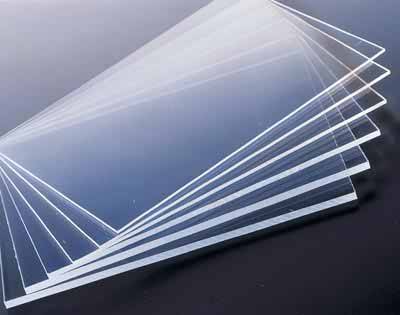
Plexiglas and Lexan
To begin with, let's settle the naming issue.
Plexiglas® and Lexan® are trademarked brand names (belonging to Roehm & Hass and GE Plastics, respectively). Each belongs to a different family of plastics, Plexiglas being an acrylic and Lexan being a polycarbonate. They are quite different materials, and each has pros and cons.
As such, we're going to give each its own section to explain their strengths and weaknesses.
Plexiglas ® - aka Acrylic, Lucite, Perspex and Polymethyl methacrylate
When compared to glass, plexi is generally described as more optically clear ( none of the green tint commonly seen in glass ), more impact resistant (about 10 times tougher) and it weighs about half as much as glass does. It's also quite easy to bend using a little heat, and cut edges can be polished easily. Using the right product, small scratches can be polished out of a plexiglas sheet. Pieces can also be glued together using cyanoacrylate cement (superglue).
Plexi is used in architectural glazing, large aquariums, and in many kinds of heat-formed items (furniture, store displays, curved windows in aircraft). It is considered a safer alternative to common glass in high risk areas, such as the 'glass' around hockey rinks. It is also commonly used in the sign industry. Plexiglas powder is also used as a dispersant for ceramic powders to stabilize colloidal suspensions in non-aqueous mediums. I have no idea what that means, but it sounds important.
Cons - Plexi scratches. It can be chipped or cracked if dropped or hit hard enough. It's more expensive than glass, and has a tendency to build up a static charge which attracts dust. Under the right conditions (or the wrong conditions, depending on your perspective) Plexiglas will burn.
Lexan ® - aka Makrolon, Makroclear and Polycarbonate
Lexan is a step up in safety from plexiglas. It's more impact resistant than common glass or plexi (about 30 times tougher than glass) and almost as optically clear as plexiglas. While a touch heavier than plexi, it is still lighter than glass. Thermoforming Lexan is a bit harder, but it is much easier to cut and drill, and with the right equipment it can be formed at room temperature just like metal. It doesn't crack or chip easily. Lexan is actually marketed as 'Virtually Unbreakable'
Lexan is used in places where impact resistance is critical. Items such as safety lenses, police riot shields and visors, instrument panels and headlamp lenses. A lot of bullet proof glass is actually very thick Lexan. Lexan is also commonly used for plastic drink bottles and CDs / DVDs.
Cons - Lexan scratches. Very easily. It's also more expensive than plexi or glass. Except for specially formulated UV resistant varieties, Lexan will yellow over time. Under high heat conditions, Lexan will melt



